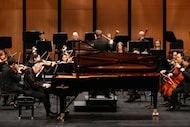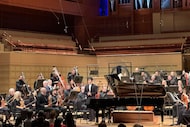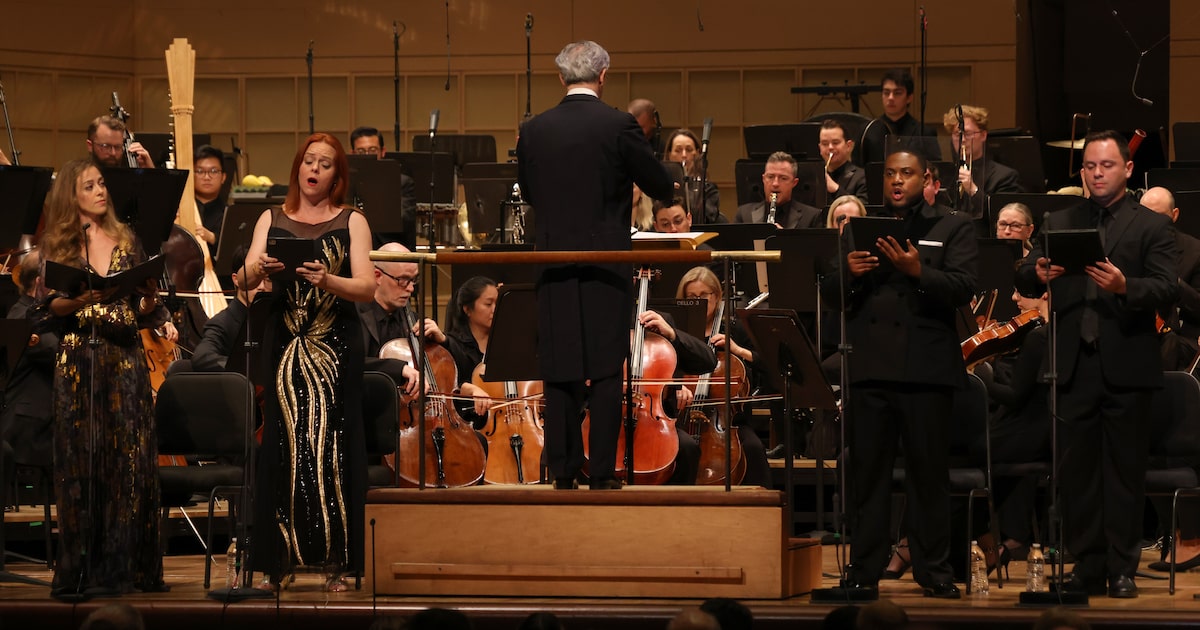Thursday night’s Dallas Symphony Orchestra concert, at the Meyerson Symphony Center, was presented in the orchestra’s Classical series, and it was led by music director Fabio Luisi. But its second half would have fit right in the Pops series: Gershwin’s Rhapsody in Blue, with pianist Inon Barnatan, and Morton Gould’s Latin-American Symphonette.
The very different first half presented the premiere of the DSO-commissioned For everything you keep losing, a 35-minute quasi-requiem by Puerto Rico-born Angélica Negrón.
All three works were by American composers. And all three composers have dressed popular idioms in symphonic raiment (Gershwin with orchestration by Ferde Grofé), although only the “Libera me” section of Negrón’s present work suggests jazzy Latin rhythms.
Scored for four soloists, chorus and orchestra, Negrón’s is a requiem more for places and things than for people. Each of the seven movements begins with words from the Latin Requiem Mass, followed by poetic lines touching on broader concepts of loss, by Roque Raquel Salas Rivera, Ricardo Alberto Maldonado, Nicole Delgado and Amanda Hernández. (Britten’s War Requiem, interleaving Requiem texts with Wilfred Owen’s war poems, is a precursor of sorts.)
News Roundups
Much of the work is surprisingly lush, with rich washes of choral writing, although the quasi-symbolist poetry — sometimes spoken rather than sung — evinces little connection to the Latin texts.
The orchestra supplies pleasant murmurs, hypnotic pulsings, pretty bird twitters and occasionally rousing assertions. But rarely is the orchestral writing particularly arresting.
The performance had excellent soloists in soprano Lauren Snouffer, mezzo Kimberly Gratland James, countertenor Key’mon Murrah and tenor Paul Appleby, although they were sometimes swamped by chorus and orchestra.
Some of the imbalances may be built into the score, but I wondered if a firmer hand from the podium might have helped. Maybe also a more compact version of the Dallas Symphony Chorus, prepared by director Anthony Blake Clark and filling the Meyerson’s choral terrace. A more focused choral sound would have been welcome, too.
Having Negrón speak beforehand helped humanize the experience, although her words sometimes got swallowed up in the acoustics. Texts were projected over the stage, but it’s too bad the audience wasn’t given printed ones for subsequent reflection.
The audience was thrilled by the Gershwin, judging by the roaring ovation — rewarded with Earl Wild’s virtuoso sendup of “I Got Rhythm.” But this Rhapsody struck me as too often raucous, devoid of grace, of charm, of easy playfulness. In solo passages Barnatan stretched lines almost to breaking points, and both he and Luisi whipped up scorching fortissimos. This is a subtler piece than it was allowed to be.
Gould, who lived from 1913 to 1996, was a master of flashy orchestral writing, and his four-movement Latin-American Symphonette, from 1940, has toe-tapping, hip-swaying fun with, respectively, the Rhumba, Tango, Guaracha and Conga. It got an appropriately razzle-dazzle performance.
Details
Repeats at 7:30 p.m. Friday and Saturday at Meyerson Symphony Center, 2301 Flora St. $37 to $195. 214-849-4376, dallassymphony.org.
 Review: A splendidly refreshing Dallas Chamber Symphony concert
Review: A splendidly refreshing Dallas Chamber Symphony concert
The program included a rare performance of Poulenc’s Piano Concerto, with Anton Nel the spirited soloist.
 Review: A Dallas Symphony concert of Respighi and Saint-Saëns showpieces
Review: A Dallas Symphony concert of Respighi and Saint-Saëns showpieces
A recent work by composer-in-residence Sophia Jani supplied evocative contrast.

